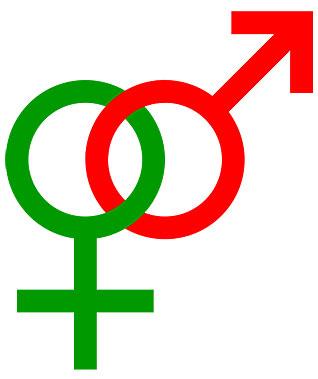Columnists
Our War of the Sexes
by I.J. SINGH & GURMEET KAUR
We are both well aware of the fundamentals of Sikh teaching that reiterate equality for men and women, and so forth. That's not where this essay begins.
We were passing the time talking about this and that, and about March 8 that was commemorated over the world as "Women's Day", when our thoughts turned to how young Sikhs view their mates these days.
Naturally, for starters, we went on to peruse the "Matrimonials" in the ethnic press, and also talked to a few young Sikhs of both sexes.
What flabbergasted us was how many young men look for "China dolls," and how many young women, otherwise dedicated Sikhs, opt for the "clean-shaven" look. Sometimes they even hunt for a "clean-shaven gursikh". Admittedly, there are very few ads that are quite so moronic, but to us it remains a classic oxymoron, like labelling someone a God-fearing atheist.
It seems that many young Sikh keshadhari males feel undesired and rejected, by their Sikh women counterparts. Not a desirable place to be for a growing young man, we thought.
Equally disturbing is the other side of the spectrum. "Saabat soorat" gursikh women (especially the ones that don a dastaar) have trouble finding matches, although they are not so vocal about it and don't often publicly decry Sikh men's craving for Bollywood models or look-alikes for their wives.
In this litany of how skewed is our thinking in such matters, one must add the undeniable fact that in our culture, for a woman the probability of finding a spouse, if she is divorced or has a child, is infinitesimally small.
Go to any function in any gurdwara and there is no way to escape the continual hum of conversation that permeates the assemblage, men and women, but largely emanates from the women.
This kind of rumination brought us to the question: what exactly is the place of the mother in a family beyond carrying the fetus for the necessary gestational period? What is the meaning of responsible parenting?
For a baby, we would think it takes more than keeping one end full and the other end dry, and as the baby grows, it means more than providing the right sex- and age- specific toys - from a Barbie doll or an iPod to a BMW.
We were intrigued by the Jewish maxim that any child born of a Jewish mother is by definition a Jew, irrespective of the father's religious affiliation, or the circumstances in which the child was conceived or born. (This is not the position in all of Judaic thought. For the Orthodox, marrying outside their tradition is not accepted and may result in shunning by the community.)
The idea of matrilineal transmission of Jewish faith most likely emerged from the never easy and contentious existence of the Jews. In their history of long-standing persecution, fatherhood was not always clearly established, and the child unquestionably remained a mother's responsibility.
This is vital particularly in view of the fact that some Orthodox Jewish religious practices are heavily loaded in favour of patriarchy. For example, remember that a minyan (quorum required to conduct a communal religious service) consists of ten men; nine men and one woman would not do.
Keep in mind also that, in some Jewish practices, a woman undergoes a ritual purification every month after her menstrual period, and may not attend religious services during that time.
[We need to add that mainstream Judaism accepts women as full partners without any of these caveats.]
Yet, the belief that the mother is the primary element in defining the faith of a newborn is recognition of her central place. Why? Because, since the dawn of our existence, men have often been somewhat absentee fathers, even if it was only as hunters-gatherers. The human newborn is entirely helpless at birth and dependent on the mother for survival.
Even though not universally accepted in Jewish belief and practice, the dictum that a Jewish woman's child is a Jew recognizes the pivotal place of the mother in the life of a child. It says that even if a Jewish woman marries outside her faith, or the child is of uncertain paternity, she is duty-bound to raise it as a Jew. In fact, the non-Jewish parent then is adding to the richness of the gene pool of the Jewish people. Furthermore, this attitude doesn't isolate the Jewish people from their neighbours of other faiths.
The Sikhs, as we see it, have evolved a very confusing set of parameters in the matter of raising a child. Whereas the responsibilities of a Sikh mother in raising a Gursikh child are critically noticed, her rights are invariably diminished.
In spite of the undeniably equal place that our doctrine provides women, our culture has always been an extreme patriarchy. Perhaps the reasons were socioeconomic, in a community that was largely agrarian until only a generation or two ago.
To a farming people, as many Sikhs still are, landholdings are the key to survival and prosperity. Thus, practices developed to reject alliances and cultural models wherein familial land would get divided over generations. Progressively smaller holdings guaranteed a downward economic spiral.
So a culture evolved in which the bride married into the family of the groom, and automatically adopted the new lifestyle, even the religion of the groom. Often she was also renamed by the groom and his family. She was given a reasonable dowry at marriage by her parents and, in turn, relinquished any claims to family property or land thereafter.
It was as if at marriage a bride sundered all ties to her birth family. This model remains operational even today, even though it is now considerably strained and attenuated.
In this simplified narrative, the bride's existence, though extremely busy in her new joint-family, was considerably simplified. If her husband and his family were good Sikhs, she adopted good Sikh practices; if they practiced a mixed lifestyle, so did she and her children.
In this male-dominated Sikh existence, women developed few independent voices; consequently, we have written women out of our historical narrative and religious practices. We point to the fact that women are not allowed to perform kirtan at the premier Sikh historical gurdwaras, including the Harmandar Sahib at Amritsar.
They are only fleetingly and minimally mentioned in history. Their voices are rarely if ever heard in matters of gurdwara management, pretty much anywhere in the world. They are visible in gurdwaras as silent (even distracting) spectators or busy preparing the langar, never as equal partners.
We illustrate our concerns by two telling examples.
Many erudite writers insist that there were no women at the dramatic Vaisakhi of 1699 where the Khalsa identity was forged. On the other hand, we doubt that the crowd of 80,000 at that time was largely or entirely devoid of women.
Two professors of Sikh Studies have argued that the Sikh Code of Conduct (Rehat Maryada) is not applicable to women, and they may cut their hair.
We think that the Rehat Maryada seems silent or ambiguous on the place of women because of the cultural realities from which we have not yet emerged. There is no logical or sensible reason for such selective myopia in interpreting Sikh doctrine or teaching.
Also, over the past fifty years, Bollywood has increasingly come to define our social existence and cultural norms. If Sikh men lust for China dolls, the women, too, look at clean-shaven hunks as their ideal beaus.
Remember that we are perhaps the last of the generation of Sikhs who learned the rudiments of Sikhism by listening to the parables of Sikhi from our mothers and grandmothers.
Now, as the world turns, times are a-changing. Women are increasingly finding a fulfilling and progressively equal place and powerful voice in secular society, but not in Sikh institutions or religious practices. The Sikh ethos remains defined in the time-honoured cultural mindset and argot that denies a woman's identity, quite contrary to all the doctrinal teaching and its spiritual import.
Over the years, we have known many Sikh families where only one parent - either the mother or the father, but not both - was deeply attached to Sikhi. It seems that the probability of the children remaining connected to Sikhi is greater when it is the mother rather than the father who alone has such ties that can be passed on to the next generation.
We Sikhs, by our cultural and tribal mores, don't even see the symbolism in the Jewish act of claiming as a Jew every child born to a Jewish woman.
The result: We have brought forth a generation of Sikh men and women who have a vague and ill-defined connection to Sikhi, and conflicting ideas of what it means to be a Sikh.
We have diminished and ignored what it means to be a Sikh wife and mother.
By participating in large-scale female foeticide, we have attempted to eliminate Sikh daughters.
By forcing arranged marriages on to the ones that survive, we repress their sense of self and spiritual relationship with the Guru that they should carry forth to their children.
By engaging in honour killings, we try to terrify the rest of them into submission and slavery or else...
One or more of these practices take place in scattered pockets of the community even though they are unequivocally prohibited by Sikh doctrine.
Where, then, are we going to find Sikh women of the next generation?
We happily add a postscript.
There are some spirited souls who are carving a new niche as liberated Gursikh women of the 21st century, but largely outside the ambit of our gurdwaras. You see them as film producers, writers, youth camp organizers, artists and even human rights activists. They seem to be creating the impetus of a new enlightenment and the power of feminine liberation.
To us the moral is clear:
Rights and responsibilities must coexist. A house divided ... or at war within ... cannot stand.
March 13, 2009
http://gurmeetkaur.blogspot.com
Conversation about this article
1: D.J. Singh (U.S.A.), March 14, 2009, 1:58 PM.
Marry the individual who walks in harmony with the Will of God (free from selfishness and conceit), and sings the glorious praises of the Lord. Such an individual is pleasing to Him and will be true to you forever. Gurbani regards all humans (male or female) as the soul-bride of their husband, God. There is therefore no justification for a war of the sexes.
2: Tejwant (U.S.A.), March 14, 2009, 2:30 PM.
Until we Sikh men shed our macho skins for good and become feminists like Guru Nanak, we shall remain Sikhs in names and in appearance only, showing off our well-starched pugghs and moussed whiskers. Without this realization, we shall remain like facades without the building, lacking depth and proudfully gaudy. In order for us to become true Nanak feminists, parroting number of paatths or cramming gurbani by heart would not do anything by itself, except make us more self-righteous. Studying gurbani and emulating Guru Nanak is the only step we men need to take. When this one piece of puzzle is inserted in the right place, then Sikhi will become what it is supposed to be.
3: Amardeep (U.S.A.), March 14, 2009, 3:16 PM.
If someone has even an iota of love for Sikhi, why drop it after marriage? Where there is a will, there is a way. I see, females trying to please the husband and in-laws only. Why not please God following Gurbani principles? All Bhagats loved God against all resistance/odds. If someone has love for God, God will protect that person against all in-laws/husband (written so many times in gurbani). I know that people like me are good at talking only, not doing/following.
4: Amardeep (U.S.A.), March 15, 2009, 3:17 PM.
One of the more important points already stressed in this article is that if more females are not attached to Sikhi, they will in turn create more pressure/demand for clean shaven Sikhs. And everyone can agree the important role of the mother in raising a Gursikh. Therefore, how important it is to let females shine in our gurdwaras, nourish their love for Sikhi and in turn, build on their spirituality. Anyone with love for Sikhi should be fighting for equal rights for women, as our Gurus did.
5: H.S. (New York City U.S.A.), March 16, 2009, 11:58 AM.
"Iss jugg meh Purakh ek hai, hor saglee naar sabaayee ||" Those who do not value gurbani may dabble in this "war of the sexes". Those who do understand (sometimes) the value of gurbani but still live enmeshed in their ego (either from the male-dominant societal view or the female's unequal representation view) may take forever to understand the Guru and Sikhi. 'Woman Power' is nothing different than Power of the Eternal Waheguru. Same goes with Male 'Power'. Womanhood and Manhood are merely robes, a garment that the Soul has worn. Neither does it matter if the colour of the robe is black, brown or white, as it doesn't matter whether the robe has male or female features. This Soul is on a continuous journey, having started from a breakaway action from its Origin - Waheguru - and shall ultimately reach its destination - Waheguru. Every Soul has been sent with a purpose, with specific aims/projects/targets which need to get accomplished. Gurbani continuously reminds us all that we are not bodies, we are souls, and reinforces the pang of separation and yearning to re-unite with our Beloved Husband, getting imbued in His colours of Love (Naam) and ultimately getting Ikmik with Waheguru. "Karamheen dhan karey binantee, Kad Nanak aavey vaaree || Sabh suhagan manneh raleeyaa, Ik devoh raat muraaree ||" - "Hou tumree karo nit aas, Prabh mohey kabh gal laavenhgey ||"
6: Sharan (Australia), March 16, 2009, 10:09 PM.
According to our scripture, all debates and discussions on such matters, including spiritual - without the necessary prerequisite - are futile (shocking as this sounds to most of us). For, as Guru Nanak says, we need to first and foremost find out the purpose of why we are here. Most debates or discussions reflect our focus on the outer. This is not to mean we should become indifferent to what is around us. No, but to really start to gain some insight or understanding as to why things are the way they are, good and bad, equal and unequal - or the way they should be - we need to "hear" what the Guru Granth has to say.
7: Kulbir Singh Sevadar (Sydney, Australia), March 17, 2009, 5:37 AM.
How do the authors then explain our Sikh Rehat Maryada which clearly states that "A Sikh must marry his daughter to a Sikh"? Whereas there appears to be no restriction on him to marry his son to a Sikh girl!
8: Navjeet Singh (Chandigarh, Punjab), March 17, 2009, 7:01 AM.
I fully agree and support the points made in the article. I'm a 20-yr old engineering student. One day, while I was sitting with my friends, talk regarding finding a suitable match (we meant - girlfriend) started. My friends said, "You must be looking for a Singhni." I nodded and said yes. I tried to find out how many Singhni do I come across? It has been 48 days and I have met one to date ... A terrible situation! Where are the Sikh women? "The result: We have brought forth a generation of Sikh men and women who have a vague and ill-defined connection to Sikhi, and conflicting ideas of what it means to be a Sikh." This is what I think the Sikh preachers, scholars, messengers need to ponder over. A very well written article and put up at a time when it is most needed.
9: Arvinder Singh Kang (Oxford, MS, U.S.A.), March 17, 2009, 3:04 PM.
Quote: "Sometimes they even hunt for a "clean-shaven gursikh". Funny but true, I suppose! Next time I'm ordering yummy fries with no oil and no potatoes in it!
10: Raminder (New Jersey, U.S.A.), March 18, 2009, 9:10 PM.
Point well made. We need to isolate the drivers of these perceptions and behaviours. Muslim women, despite bad treatment, are raising very strong Muslim men. In a majority of situations I have seen men sporting turbans whereas their women have their hair cut. To change the Sikh world, we need to make our daughters strong. If they are strong and appreciate Gursikhi, men will follow. Maharaja Ranjit Singh didn't become Maharaja on his own. He was guided by a strong woman. Mata Gujri made the Sahibzadeh strong enough to take on the whole darbar. Our history is full of such examples. So, what are we missing now? To make Sikhi strong, we'll have to make our daughters stronger!
11: S. Singh (U.S.A), March 20, 2009, 10:16 AM.
The authors posit their central question of the article as "what exactly is the place of the mother in a family beyond carrying the fetus for the necessary gestational period? What is the meaning of responsible parenting?" But this article, like several other articles of its kind, is incomplete with addressing the other half of the question: "what exactly is the place of the father in a family beyond implanting sperm for the necessary conception? What is the meaning of responsible parenting?" Members of a society do not operate in a social vacuum. There is a dialectic relationship between men and women, such that each is defining the other. For example, the longings for China-doll and clean-shaven hulks mutually affect, shape and reinforce the tensions in the matrimonial quests of the Sikh youths. Hence the need for discussing the place of Sikh fathers while discussing that of Sikh mothers. The authors lament, "We have diminished and ignored what it means to be a Sikh wife and mother." But if we study the discourse in our Sikh community about marriage, parenting, raising children, Sikh values, etc., it will show that the discussion of what it means to be a Sikh husband and father is largely missing in this discourse. It appears in an infrequent and scattered format, not as a running theme in the same way as that of Sikh women/ wives/ mothers. Finally, in the article I sensed an implicit glorification of the significance of women in Jewish faith. It will be an interesting exercise to hear what Jewish women have to say about their experiences. The article is well-intended. On the occasion of Women's Day, it draws attention to the inequal status/rights of women in Sikh society while attempting to balance the discussion of rights versus responsibilities. This is all good. But any such discussion will be incomplete without also the discussion of Sikh fathers. And not as another chapter, but on the same page. But for now, I will look forward to the part-2 of this article by the authors who write so well. Thanks for the part-1.






